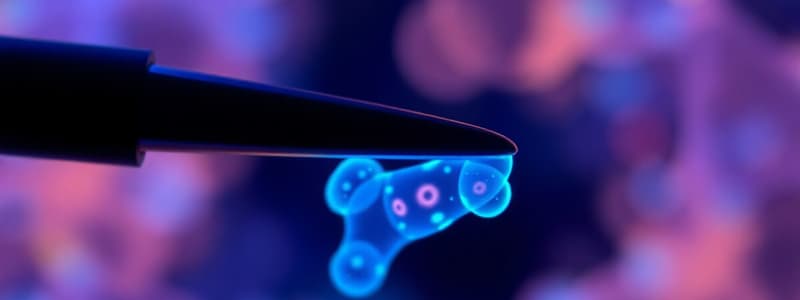Podcast
Questions and Answers
Which of the following statements accurately describes the difference in specificity between Direct Immunofluorescence (DIF) and Indirect Immunofluorescence Assay (IDIFA)?
Which of the following statements accurately describes the difference in specificity between Direct Immunofluorescence (DIF) and Indirect Immunofluorescence Assay (IDIFA)?
- DIF is more specific, requiring the primary antibody to be directly conjugated to a fluorescent dye, while IDIFA can target a wider range of antigens.
- The specificity of both assays is similar, as they both utilize a fluorescently labeled antibody directly bound to the antigen.
- IDIFA demonstrates higher specificity due to the use of a labeled secondary antibody, while DIF is limited to the labeled antibody. (correct)
- DIF is more versatile, allowing for the use of different primary antibodies, while IDIFA is limited by the labeled antibody.
- DIF is less specific due to the use of a labeled secondary antibody, while IDIFA demonstrates greater specificity by using a labeled primary antibody.
In terms of sensitivity, what advantage does the Indirect Immunofluorescence Assay (IDIFA) have over the Direct Immunofluorescence (DIF) assay?
In terms of sensitivity, what advantage does the Indirect Immunofluorescence Assay (IDIFA) have over the Direct Immunofluorescence (DIF) assay?
- The sensitivity of both assays is comparable, as both utilize fluorescently labeled antibodies for antigen detection.
- IDIFA utilizes a single step for antigen detection, leading to faster and more sensitive results.
- DIF demonstrates higher sensitivity due to the direct binding of a labeled antibody to the antigen, eliminating the need for secondary antibody binding.
- IDIFA utilizes a second, labeled secondary antibody, resulting in signal amplification and enhanced sensitivity. (correct)
- DIF allows for the use of different secondary antibodies, which increases the assay’s sensitivity.
Which application is most commonly associated with the Indirect Immunofluorescence Assay (IDIFA)?
Which application is most commonly associated with the Indirect Immunofluorescence Assay (IDIFA)?
- Analyzing the expression of specific proteins in tissue samples for research and diagnostic purposes.
- Identifying specific tissue-bound antigens in biopsies, enabling the diagnosis of various diseases.
- Monitoring antigen expression in cell cultures for research purposes.
- Detecting the presence of antibodies in patient serum samples, indicating autoimmune or infectious diseases. (correct)
- Rapidly diagnosing infectious diseases in clinical settings where immediate results are crucial.
What is a significant difference in the cost and time required for the Direct Immunofluorescence (DIF) assay compared to the Indirect Immunofluorescence Assay (IDIFA)?
What is a significant difference in the cost and time required for the Direct Immunofluorescence (DIF) assay compared to the Indirect Immunofluorescence Assay (IDIFA)?
Which of the following statements correctly describes the difference in the number of steps involved in the Direct Immunofluorescence (DIF) and Indirect Immunofluorescence Assay (IDIFA)?
Which of the following statements correctly describes the difference in the number of steps involved in the Direct Immunofluorescence (DIF) and Indirect Immunofluorescence Assay (IDIFA)?
Which of the following are NOT steps involved in Direct Immunofluorescence (DIF)?
Which of the following are NOT steps involved in Direct Immunofluorescence (DIF)?
In Indirect Immunofluorescence Assay (IDIFA), what is the purpose of the secondary antibody?
In Indirect Immunofluorescence Assay (IDIFA), what is the purpose of the secondary antibody?
What is the primary purpose of using a fluorescent dye in Immunofluorescence techniques?
What is the primary purpose of using a fluorescent dye in Immunofluorescence techniques?
Which of the following is NOT a characteristic of Immunofluorescence microscopy?
Which of the following is NOT a characteristic of Immunofluorescence microscopy?
In Direct Immunofluorescence (DIF), what is the role of the primary antibody?
In Direct Immunofluorescence (DIF), what is the role of the primary antibody?
Which of the following is a common application of Immunofluorescence?
Which of the following is a common application of Immunofluorescence?
What type of light is typically used to excite the fluorescent dye in Immunofluorescence microscopy?
What type of light is typically used to excite the fluorescent dye in Immunofluorescence microscopy?
Why is the Indirect Immunofluorescence Assay (IDIFA) considered more sensitive than Direct Immunofluorescence (DIF)?
Why is the Indirect Immunofluorescence Assay (IDIFA) considered more sensitive than Direct Immunofluorescence (DIF)?
Flashcards
Direct Immunofluorescence (DIF)
Direct Immunofluorescence (DIF)
Detects antigens using a primary fluorescently labeled antibody.
Indirect Immunofluorescence Assay (IDIFA)
Indirect Immunofluorescence Assay (IDIFA)
Detects antibodies in serum using a secondary fluorescently labeled antibody.
Specificity
Specificity
Ability to identify the correct antigens or antibodies.
Sensitivity
Sensitivity
Signup and view all the flashcards
Time and Cost Comparison
Time and Cost Comparison
Signup and view all the flashcards
Immunofluorescence
Immunofluorescence
Signup and view all the flashcards
Fluorescein Isothiocyanate (FITC)
Fluorescein Isothiocyanate (FITC)
Signup and view all the flashcards
Tetramethylrhodamine
Tetramethylrhodamine
Signup and view all the flashcards
Sample Preparation in DIF
Sample Preparation in DIF
Signup and view all the flashcards
Antigen Coating in IDIFA
Antigen Coating in IDIFA
Signup and view all the flashcards
Fluorescence Detection
Fluorescence Detection
Signup and view all the flashcards
Study Notes
Immunofluorescence
- Immunofluorescence is a technique visualizing a specific antigen.
- A specific antibody is chemically conjugated with a fluorescence dye.
- Fluorophores (e.g., fluorescein isothiocyanate (FITC)) absorb short UV wavelengths.
- Fluorophores emit longer wavelengths (visible light) for visualization.
- Examples include FITC (green) and tetramethylrhodamine (red).
- Immunofluorescence can highlight viral plaques.
Principle of Immunofluorescence (IF)
- IF is based on antigen-antibody interactions.
- Labeled antibodies bind to specific antigens.
- UV or specific wavelengths expose the fluorescent dye.
- The dye emits visible light.
- This allows visualization of antigen-antibody complexes.
Principle of the Test (IF)
- Cells with antigens are on slides.
- Specific antibodies are tagged with a fluorophore.
- Antibodies bind to targeted antigen.
- Creating a complex between antigen, antibodies, and labeled antibodies.
- Specific antibodies are used to find antigens on cells.
Requirements for Immunofluorescence
- Microscope with specific filters
- Fluorescently tagged antibodies.
- Slides of specimens.
- Sample preparation
Methods of IF Assay
- There are two types:
- Direct (uses a primary antibody linked to fluorophore).
- Indirect (uses primary antibodies that bind to specific antigens, followed by a secondary antibody also labeled with a fluorophore)
Direct Immunofluorescence (DIF)
- Used to detect specific antigens.
- A primary antibody directly binds to the target antigen.
- Fluorescently label the primary antibody.
- Sample preparations: tissue sections or cells are fixed to a slide.
- Detect the target antigens by fluorescence microscopy. A positive result confirms the presence of the target antigen.
Indirect Immunofluorescence Assay (IDIFA)
- Detects specific antibodies in a biological sample (e.g., serum).
- It uses a known antigen to bind antibodies and fluorescently tagged antibody.
- A substrate or slide is coated with an antigen.
- Patient serum (containing antibodies) is added to the slide.
- Positive binding confirms the presence of the specific antibodies.
Results of Immunofluorescence
- Confocal image showing phosphorylated AKT (green) in cardiomyocytes infected with adenovirus.
Comparison of Direct and Indirect Methods
- Direct is faster, cheaper, and detects antigens directly.
- Indirect is more versatile, detects antibodies, and offers higher sensitivity due to signal amplification.
- Choice depends on if looking for antigens or antibodies.
Studying That Suits You
Use AI to generate personalized quizzes and flashcards to suit your learning preferences.




